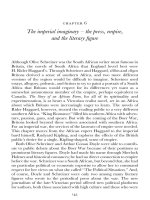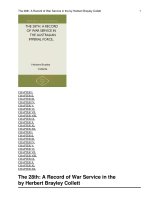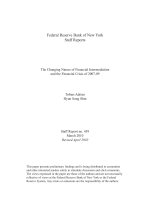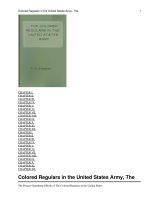ACERBI-The-Austrian-Imperial-Army-1805-09
Bạn đang xem bản rút gọn của tài liệu. Xem và tải ngay bản đầy đủ của tài liệu tại đây (3.72 MB, 204 trang )
Enrico Acerbi
The Austrian
Imperial-Royal Army
1805-1809
Placed on the Napoleon Series: February-September 2010
Oberoesterreicher Regimente: IR 3 - IR 4 - IR 14 - IR 45 - IR 49 - IR 59 - Garnison - Inner
Oesterreicher Regiment IR 43
Inner Oersterreicher Regiment IR 13 - IR 16 - IR 26 - IR 27 - IR 43
Mahren un Schlesische Regiment IR 1 - IR 7 - IR 8 - IR 10
Mahren und Schlesischge Regiment IR 12 - IR 15 - IR 20 - IR 22
Mahren und Schlesische Regiment IR 29 - IR 40 - IR 56 - IR 57
Galician Regiments IR 9 - IR 23 - IR 24 - IR 30
Galician Regiments IR 38 - IR 41 - IR 44 - IR 46
Galician Regiments IR 50 - IR 55 - IR 58 - IR 63
Bohmisches IR 11 - IR 54 - IR 21 - IR 28
Bohmisches IR 17 - IR 18 - IR 36 - IR 42
Bohmisches IR 35 - IR 25 - IR 47
Austrian Cavalry - Cuirassiers in 1809
Dragoner - Chevauxlégers 1809
K.K. Stabs-Dragoner abteilungen, 1-5 DR, 1-6 Chevauxlégers
Vienna Buergerkorps
The Austrian Imperial-Royal Army (Kaiserliche-Königliche
Heer) 1805 – 1809: Introduction
By Enrico Acerbi
The following table explains why the year 1809 (Anno Neun in Austria) was chosen in order to
present one of the most powerful armies of the Napoleonic Era. In that disgraceful year (for Austria)
the Habsburg Empire launched a campaign with the greatest military contingent, of about 630.000
men. This powerful army, however, was stopped by one of the more brilliant and hazardous
campaign of Napoléon, was battered and weakened till the following years.
Year
1650
1673
1690
1706
1735
1777
1788
1792
1792-1796
1800
Emperor
Leopold I
Joseph I
Carl III
Maria Theresia
Joseph II
Event
Contingent (men)
Thirty Years War
150000
60000
97000
Erzherzog Eugen
130000
150000
Seven Years War
200000
244000
Turks War
364000
Peacetime
290000
Revolutionary Wars 314000-500000
495000
1802
462000
1803
310000
1804
355000
1806
Franz I
345000
1808
390000
1809
630000 [1]
1810
290000
1811
233000
Source: Neue Statistisch-Geographische Beschreibung des Königreichs Ungarn,
Croatien, Slavonien und der ungarischen Militär Grenze, Weygand, Leipzig 1832
The Austrian Military Reforms
Evolution of the Infantry Units 1802-1816 (source Wrede) [2]
Date
1802
1805
Peace
3
6
War
3
6
1805
1806
Peace
4
4
War
Peace
War
Peace
War
5
2
3
4
6
6
3
6
1807
1809
1809
1816
24
German
Hungarian
Regiments
Regiments
Grenadier Regiment
companies
Companies
companies
Staff
Reserve
Reserve
Line
Line
Depot
Depot
4
167
207
142
46
companies
192
233
212
212
143
53
20
120
#
Regiment
Grenadier
Stand Bat. Companies
Total
Companies
Each
Companies
2
4*
2
2
20
24
18
20
20
30 (22) **
129
201
215
201
212
186
206
4
4
companies
companies
198
219
186
440
206 Res.Depot
***
218
208
238
129
46
201
136
145
136
145
51
70
75
70
75
* independent battalions - ** included two Landwehr battalions (only for Erbländer or Imperial
hereditary provinces) each with 6 companies - *** Hungarian Reserve Depot (one division) had two
companies (440 men in peace and 208 in war)
Authorized Strength Numbers for Regiments
Date
Stand
German
Regiments
line
Hungarian
Regiments
line
1802
1805
Peace
3348
4068
852
--
1242
War
4838
5198
858
--
1272
1805
1806
Peace
2884
2884
516 *
--
774
War
4163
4163
804 *
--
1206
Peace
3318
3638
816
--
1236
War
4053
4401
870
--
1314
Peace
3318
3638
816
--
1236
War
5160
5063
870
1308
1428
1807
1809
1809
1816
Grenadier Landwehr Grenzer
Battalions Battalions Battalions
notes
After 1809
regiment’s Artillery
(service or
“bedienung” of 97
men) was lost
Hungarian line
regiments. Had one
Reserve division as
Depot
* With 4 companies each – two veteran, old or Alt-Grenadiere companies (with the fur cap) - two
young or Jung Grenadiere companies (with shako)
The nominal number of the Gemeinen (common troopers) of a company was 160. After the 1809
disaster the numbers of the soldiers went down to 60 in the German regiments and 100 in the
Hungarian regiments.
The nominal number of the grenadiers of a company was 120 in the German regiments and 150-160
in the Hungarian regiments
These numbers was not always rigid. In Octobere 1805, for example, in Italy the Austrian army
was noticeably reinforced. There, the Infantry regiments had 4 fusiliers battalions plus one
Grenadier’s battalion, which remained by its regiment. Two Infantry regiments formed a brigade.
On October 18, 1805, as regular order of battle, every Infantry brigade had a 3 pdr battery (no
artillery for cavalry brigades). The regiments moved with their own artillery and, for this, was
formed a special support reserve of 180 2-horse drawn carriages (Karren) and 33 4-horse drawn
ammunition wagons (Leiterwagen). The artillery park was, as in the previous campaigns, at
Palmanova in Friuli.
Austrian Army 1807-1812 Schemes[3]
After 1800 and the first army reorganization, the Austrian army or K.K. Österreichisches Heer
improved its organization with a new recruiting system and the widening of the duty services,
created new units and enlarged the Hungarian troops (probably either for having lost a large amount
of crown lands, either under the direct French threats). As said, the great test for this new army
completely failed in 1809. At the end of 1807 the forces (“Stande”) of the Austrian army was the
following:
Infantry: 63 Line Infantry regiments -- 1 Jäger Infantry regiment -- 17 National-Grenzregimenter
or Military Border regiments.
Cavalry: 8 Cuirassier regiments -- 6 Dragoon regiments -- 6 Chevaulégers regiments -- 12 Hussars
regiments -- 3 Uhlans regiments
Artillery: 4 Feldartillerie regiments.
Staff: (see the following dictionary of army ranks for details upon Austrian names)
Engineers: (Geniedirektor or Engineers commander: Archduke John)
Engineers Corps or Ingenieur Korps: 4 FML, 5 GM, 6 colonels, 8 Lieut.colonels, 12 majors, 64
captains, 47 lieutenants
Miners or Mineur Korps: 1 Colonel, 1 Lieut.Colonel, 1 major, 4 captains, 4 lieutenants, 4 Second
lieutenant, 1 adjutant, 4 companies of 100 men.
Generalquartiermeister Staff: (GM Mayer), 4 colonels, 6 lieutenant colonels, 14 majors, 23
captains, 13 lieutenants scattered in the territory, fortresses, major cities, the military border, and
sometimes named when needed.
Pontooners (Battalion Czaikisten): 1 colonel, 5 captains, 6 lieutenants, 6 second lieutenant, 11
Oberbrückenmeister (a kind of sergeant major), 6 companies each with 100 men.
Military Train (Militärfuhrwesens Korps): 1 colonel, 1 lieutenant colonel, 1 major, 6 Premierrittmeister (first captain), 9 second-rittmeister (2nd captain), 26 lieutenants, 34 second lieutenant, 11
adjutanten scattered in the train (Fuhrwesens) divisions of the major cities.
Remountierung-Beschälswesens (horse breeding and horse replacements providers): 2
colonels, 2 lieutenant colonels, 2 majors, 3 rittmeister (scattered among the stations of Mezöhegyés,
Meskowitz, Brandeis, Olmütz, Kolnitz, Vienna and Wels).
Kriegskommissariat (War Commissioner): 22 Oberkriegskommissäre, 72 Feldkriegskommissäre,
74 Kriegskommissariat officers (scattered in countryland, provinces).
Militär-Ökonomie-Commissionen and Depots (Commissioners for Military Economy and
Depots): at Stockerau, Prague, Alt-Ofen (now Budapest), Brünn, Podgorze, Jaroslaw, Marburg,
Karlsburg and Vienna (each with 1 Staff officer, 1 captain and 2 lieutenants).
Invalidenhäuser (Hospitals for Invalids): Vienna, Prague, Turnau, Pettau (each with a
commander, a Staff officer, 1 Auditor, 1 Rechnungsführer, 1 adjutant, 1 arzt (surgeon), 1 kaplan
(priest), 1 Kriegscommissär).
Military academies: Vienna (Engineers), Wiener-Neustadt (Cadets), Joseph-Akademie of Vienna
(medical service), Thierarznei-und Thierspital-Institutof Vienna (veterinary).
Military Police (Wiener Militär-Polizeiwache): at Vienna. Mounted and foot “gendarmes”. (2
captains, 1 lieutenant and 1 second lieutenant, 1 adjutant and 300 policemen.
Imperial Guard (Leibgarde)
1
2
1
3
1
Adelige erste Arcieren Leibgarde
Kapitän-leutnant (lieutenantHauptmann (captain)
2
captains)
Oberlieutenant
1
Unterlieutenant
Premier-Wachtmeister
5
Second-Wachtmeister
Vize-Second Wachtmeister
60
Garden (guards)
Kaplan (priest)
1
Auditor
1
Kasseverwalter
1
Oberarzt
1
2
1
1
1
1
2
1
1
10
1
Adjutant
Ungarische adelige Leibgarde
Käpitan (captain)
1 Kapitän-leutnant (Lieut-captains)
Premier-Wachtmeister
4
Second-Wachtmeister
Kaplan (priest)
52
Garden (guards)
Rechnungsführer
1
Auditor
Arzt
1
Adjutant
Trabanten Leibgarde
Hauptmann (captain)
1
Kapitän-leutnant (Lieutenant-captains)
Oberlieutenant
1
Premier-Wachtmeister
Hofburgwache
Hauptmann (captain)
1
Oberlieutenant
Unterlieutenant
2
Feldwebel
Korporale
154
gemeine
The German Line Infantry [4]
The line infantry had regiments with 2 grenadier companies and 16 fusilier companies. The
regiment was split in three battalions: the 1st or Leibbattalion, the 2nd or Oberstbattalion (both with
6 companies), the 3rd or Oberstlieutenantsbattalion with 4 companies.
An Infantry company had:
Staff
1
1
1
6
2
3
German Regiment Fusilier Company – 186 men
Hauptmann or Capitain-Lieutenant
1
Oberlieutenant
Fähnrich or Führer
Unterlieutenant
1
(Ensign)
Feldwebel
2
Gefreyte
Corporalen
1
Fourierschützen
Tambouren
1
Zimmermann
Privatdiener
160
Gemeine
German Infantry Grenadier Company (end of 1807)
Staff
German Regiment Grenadier Company
1
Hauptmann or Capitain-Lieutenant
1
Oberlieutenant
1
Unterlieutenant
1
Feldwebel
6
Corporalen
1
Fourierschützen
2
Tambouren
1
Zimmermann
3
Privatdiener
140
Grenadiere
The German regiments or “Deutsch infanterie Regiments”- (those from the Erbländer or hereditary
lands and regions) in peacetime: as under August 7, 1810, Emperor Franz Order, diffused by
Hofkriegsrat compared with the new layout of August 10, 1811. The German Infantry regiments of
the Austrian army had: 2 grenadier companies and 12 fusilier companies. Each fusilier company
could have roughly 180 men (160 after 1805 and only 60 after the disaster of 1809).
Line German Infantry Regiment Staff
Oberst superior and Regiments
Inhaber (Owner)
1
Oberstlieutenant
1
Regiments Caplan (priest)
Regiments Adjutant (oberlieutenants
1
or Fähnriche)
1
1
2
1
3
Oberst and Regiments
Commandant
Majors
Regiments Auditor
Bataillonsadjutanten
(unterlieutenants or Fähnriche)
1
1
4
9
4
Regiments Rechnungsführer
Regimentsarzt
Ober-Ärzte
Führer
Fourierschützen
5
Privatdienern [5]
6
1
6
9
1
K.k. ordinäre Cadetten
Profoß
Unter-Ärzte
Fourieren
Regiments Tambour
Each battalion had one flag, which remained in the middle or in the wing (first line) of an attacking
platoon. It was carried by a Führer, who was at his officers side. Companies had four platoons
(Züge) and no sections. In peacetime there were 7 Vize-Korporalen, who were helped, in campaign,
by 1 Feldwebel and 6 Korporalen.
The Hungarian and the Siebenbürgisches (Transylvania) Line Infantry regiments of the Austrian
army had: 2 grenadier companies and 16 fusilier companies. Hungarian companies could have
around 200 men. The situation of the Hungarian Infantry regiments will be described in the
Hungarian section.
After the 1809 disaster this was the evolution of the Austrian “German” units:
German Infantry Regiments after 1811
Line German Infantry Regiment Staff
1
Oberst superior and Regiments Inhaber
1
1
1
1
1
3
9
Oberstlieutenant
Regiments Caplan
Regiments Feldarzt
Regiments Adjutant
Ober-Ärtze
Fourieren
2
1
1
6
9
1
4
Fourierschützen
8
1
Profoß
5
total
56
3
4
2
2
4
32
Line German Infantry
Regiment
Hauptleute
Oberlieutenants
Fähnriche
Führern
Fourierschützen
Grefreiten
1
4
4
24
8
10
Total
98
Oberst and Regiments
Commandant
Majore
Regiments Auditor
Regiments Rechnungsführer
K.k. ordn. Cadetten
Unter-Arzte
Regiments Tambour
Hautboisten (Hoboisten) [6]
Privatdienern
Officers and NCOs from the
Disbanded 3rd Battalions
Capitan-Lieutenant
Unterlieutenants
Feldwebeln
Corporalen
Tambouren
Privatdienern
German Infantry Company after 1811
German Grenadier Company Staff
1
1
6
2
2
Hauptmann
Unterlieutenant
Corporalen
Tambouren
Privatdiener
1
1
1
1
?
Oberlieutenant
Feldwebel
Fourierschützen
Zimmermann (carpenter)
Grenadiere (in the stated number)
German Fusilier Company Staff
1
Hauptmann or Capitain-Lieutenant
1
Oberlieutenant
1
1
6
2
Unterlieutenant
Feldwebel
Corporalen
Tambouren
1
8
1
1
Fähnrich or Führer (Ensign)
Gefreyten
Fourierschützen
Zimmermann
2
Privatdiener [7]
?
Gemeine (in the stated number)
Wishing to present the Austrian army in detail, I decided to order the various units in branch of
services, leaving only Infantry in a recruitment areas form, in an attempt to explain the Austrian
system of raising regiments by areas (Werbergänzung) or regions of the same nationality. The
following table is a numerical index of the infantry regiments with the appropriate section to look
for them. Finally I enclosed a small dictionary of the Austrian ranks, for people who wants to enter
more details.
Nationality
H=Hung
G=Germ
Facings
Colour
Buttons
Kaiser Franz
Moravia
G
pompadour red
gold
2
Hiller
Hungary-slovak
H
kaiser yellow
gold
3
Archduke Charles
Lower Austria
G
sky blue
white
4
Hoch u.Deutschmeister
Lower Austria (Vienna)
G
sky blue
gold
5
1st Garrison
dark blue
white
6
2nd Garrison
black
white
7
Schröder
Moravia
G
dark brown
white
8
Arch. Louis
Moravia
G
poppy red
gold
9
Czartoryski
Galicia
G
apple green
gold
10
Anton Mittrowski
Moravia
G
bright green
white
11
Erzherzog Rainer
Bohemia
G
rose
white
12
Manfredini
Moravia
G
dark brown
gold
13
Reisky
Küstenland
G
grass green
gold
14
Klebeck
Upper Austria
G
black
gold
15
Zach
Moravia
G
madder red
gold
16
Lusignan
Styria
G
violet
gold
17
Reuss-Plauen
Bohemia
G
light brown
white
18
Stuart
Bohemia
G
pompadour red
white
19
Alvinczy
Central Hungary
H
sky blue
white
20
Kaunitz
Moravia
G
crab red
white
21
Rohan
Bohemia
G
sea green
gold
22
Coburg
Moravia
G
kaiser yellow
white
23
Würzburg
Poland
G
poppy red
white
24
Strauch
Galicia
G
dark blue
white
25
Zedwitz
Bohemia
G
sea green
white
26
Hohenlohe
Carinthia
G
bright green
gold
27
Strassoldo
Styria
G
kaiser yellow
gold
28
Frelich
Bohemia
G
grass green
white
29
Lindenau
Moravia
G
N°
Inhaber (Owner)
1
Former/Situation
disbanded 1807 into
1st – 2nd Batt.
disbanded 1807
into 3rd – 4th Batt.
Dutch
Italy-Friaul
disbanded 1809
disbanded 1809
bleumorant (l.blue) white
30
De Ligne
31
Galicia
G
light grey
gold
Benjowsky
Transylvania
H
kaiser yellow
white
32
Eszterhazy
Central Hungary
H
sky blue
gold
33
Sztáray / Colloredo
Mansfeld
Northern Hungary
H
dark blue
white
34
Davidovich
Northern Hungary
H
madder red
white
Bohemia
G
madder red
gold
35
Arch. John Nepomuk
Argenteau
Dutch
[8]
36
Kolowrat
Bohemia
G
gris de lin (mauve)
white
37
Weidenfeld
Eastern Hungary
H
poppy red
gold
38
Württemberg
Poland
G
rose
gold
39
Duka
Eastern hungary
H
poppy red
white
40
Josef Mittrowsky
Moravia
G
crimson
white
41
Kottulinsky
Galicia
G
yellow
white
42
Erbach
Bohemia
G
orange
white
43
44
45
Simbschen
Bellegarde
De Vaux
Krain
Galicia
Salzburg
G
G
G
yellow
madder red
crimson
gold
white
gold
46
Chasteler
Galicia
G
dark blue
gold
47
Vogelsang
Bohemia
G
steel green
white
48
Vukassovich
Southern Hungary
H
steel green
gold
49
Kerpen
Lower Austria
G
pike grey
white
50
Stain
Poland
G
violet
white
51
Splény
Transylvania
H
dark blue
gold
52
Arch. Franz Carl
Southern Hungary
H
pompadour red
gold
53
Jellacic
Croatia
H
pompadour red
white
54
Froon
Bohemia
G
apple green
white
55
Reuss-Greitz
Poland
G
bleumorant
gold
56
Wenzel Colloredo
Silesia
G
steel green
gold
57
Josef Colloredo
Moravia
G
grisdelin (mauve)
gold
58
Beaulieu
Galicia
G
black
white
59
Jordis
Upper Austria
G
orange
gold
60
Gyulai
Eastern Hungary
H
steel green
white
61
St. Julien
Banat
H
grass green
gold
62
Franz Jellacic
Banat
H
grass green
white
63
Baillet
Galicia
G
light brown
gold
Dutch
disbanded 1809
Vorder Österreich
disbanded 1809
Lombardia - Italy
disbanded 1809
Italy- Tyrol
disbanded 1809
Lombardia - Italy
disbanded 1809
Dutch
disbanded 1809
Dutch
Dutch - Italy
Notes:
[1] Including Landwehr, Insurrectio (40000) and volunteers.
[2] Wrede Alphons Frhr. von: “Geschichte der K. und K. Wehrmacht”, I. Band, Wien 1898.
[3] Source: Carl Edler von Bundschuh bearb.v. „Uibersicht (sic) der bey der k.k. Oesterreichischen
Armee bestehenden Militär-Oekonomie-Systems und allen dahin Bezug nehmenden Gesetze“,
Erster Band, Prag 1812. Some numbers are very hard to read in the tables, so my apologies if few
mistakes could have occurred.
[4] In addition to what previously explained we can say that, in 1807, the term “german”, according
to the original language of people, is quite unappropriate. In effect among the so called “german”
units (which wore white trousers) there were bohemian, moravian, silesian, galician units.
Otherwise among the “hungarian” infantry there were the Transilvanian (Siebenbürgische) and
Banater units, some of which actually spoke German.
[5] Soldiers who served as personal waiters (orderly).
[6] Music band NCOs with the Feldwebel’s rank.
[7] Three in the case of the presence of a Fähnrich.
[8] Archduke John Nepomuk died on February 19, 1909. The regiment was taken by graf Eugen
Argenteau.
Placed on the Napoleon Series: February - September 2010
(In)felix Austria Essay on the Austrian Army 1805-1809
By Enrico Acerbi
«Avant un mois nous serons à Vienne! » said Napoleon during his proclamation to the army, day of the Regensburg
quarters, on April 24. On 13 May 1809, the French entered, for the second time, the Austrian capital city and seized it.
Austrian forces were, at the time, considerably weakened; they lost 50.000 men dead, wounded or prisoners; lost also
around 100 a large part of their depots and a considerable amount of horse-trained vehicles. Archduke Charles’ Army
was split in two parts; repulsed inside Bohemia, behind its former line of ope-rations, were the most of that prince’s
forces. Archduke John’s Army’s, quickly recalled towards Vienna, left Italy free for the French and Italian troops.
This long article has the target to examine the Austrian army after (during) the attempts of the Archduke Charles reform,
from the beginning of 1809 till the end of the various campaigns which caused the collapse of the Austrian military
organization. As introduction, however, it could be worthy of attention to examine the way taken by Austrian military
apparatus since the first reform that brought directly to the ruinous year 1805. It is a schematic summary useful to
understand the following organization decreed in Vienna.
Common Text Abbreviations
Abt.
Abteilung = unit (small unit in fact), detachment
FrK
Freikorps = Volunteers unit
AOK Armeeoberkommando = general headquarters
GbKan
Gebirgskanone = mountain gun
AR
Artillerieregiment = artillery regiment
GM
General Major = brigadier
Bn.
Bataillon = battalion
Hb
Haubitze = howitzer
Brig
Infanteriebrigade = infantry brigade
HKG
Hofkriegsrat = Imperial War Council
Bt
Batterie = battery
IR
Infanterieregiment
Comm. commander
Jäg.
Jäger = light infantry
comp Kompagnie = company
K.K.
Imperial-Royal
Det
Detachement = detachment
Ldwr
Landwehr
Div.
Division = infantry division
Maj.
Major
div.
division = cavalry division
Ob.
Oberst = Colonel
FJB
Feldjägerbataillon = rifle battalion (light infantry)
ObstLt.
Oberstleutnant = Lieutenant Colonel
FM
Feld-Marschall = Field-marshal
ObLt.
Oberlieutenant = 1st Lieutenant
FML Feld-Marschall Leutnant= Field-marshal lieutenant
Rgt.
Regiment
Frw
Freiwilligen = volunteer
Sqn(s).
cavalry Squadron (s)
Frh.
Freiherr = Baron
Zug
= platoon
The Fatal Destiny of the Austrian Empire till the Horrible “Anno Neun”[1]
Table: All territorial properties, gains and losses are given in “geografischen Quadrat-Meilen” (Q.M.) or Square-Miles,
that’s around 2,59 km2 .
Year
Event
Note
Gains
Losses
Peace of Austria cedes the Austrian Netherlands,
1797
Campo- Falkenstein, Lombardy, and Modena; gaining
784.63 843.47
Formio. Venice, Istria, Dalmatia, and the Gulf of Cattaro.
Austria cedes Toscana, Fristhal, and the Etsch
Peace of
1801
region. In return it gains Salzburg, Berchtesgaden,
193
392.86
Luneville.
and part of Passau.
‘Entschädigu compensates Austria, which gains Trient and
1802
100.80
ngsreceß’ Brixen, the secundogenitur part of Eichstädt.
Purchase of
1803
Lindau and
9
Rothenfels.
1804 Exchange of
2.50
Blumeneck
and other
small pieces
of ground in
Weingarten.
Austria loses Venice, Istria, Dalmatia, the Gulf of
Cattaro, Tyrol with Vorarlberg, Breisgau, and all
Peace of
Swabian manors; gaining Würzburg for the
1805
90
1410.40
Preßburg. secundogenitur, the ‘Deutsch-meisterthum’ for an
Austrian prince, and the guarantee for
compensation for the house of Oesterreich-Este.
Franz II cedes the throne of the German Empire,
and accepts the title of Emperor of Austria.
1806
Dissolving of Germany. Austrian-Würzburg joins
5
the Confederation of the Rhine and acquires the
‘Reichsrittergüter’.
Gränzreceß
1807
The Isonzo becomes the Austrian border
3
22.38
with Italy.
Austria cedes the whole Krain, Friaul, Trieste, part
of Croatia and Kärnten, the manor Rezuns,
Peace of
Salzburg, Berchtesgaden, Passau, the Inn quarter,
1809
1846.22
Vienna.
part of the Hausruck, the whole of West Galicia,
the Zamosc region, the Krakau region, and to
Russia a part of East Galicia, later to decide on.
First Archduke Charles Reforms (as president of the Hofkriegsrat[2] : Jan. 9, 1801 – 1805)
Charles, now FM (Field-marshal) and Hofkriegsrat president, in 1801 wrote to the Emperor Franz: “In the case of an
utter war we must purge every interference in the chain of command “ (the Staatsrate or the local states parliaments,
various bureaus and so on) . The Emperor followed that suggestions and, on December 1801, created the Ministry of
War (Kriegs-und Marine Ministerium) giving it to Charles and relegating the Hofkriegsrat in a second decisional line.
The Ministry concentrated all the financial matters related to the army and the war, in order to increase the investments. On December 5th, 1801 the Emperor Franz ordered a new formation of the Army, which, on February 1st,
1802 began to be reformed, by cavalry and the light troops, with the:
1 --- disbanding of the 1800’s Light infantry battalions and raising of the Tiroler-Jäger-Regiment. Also disbanded were
two old cavalry regiments, the Jäger zu Pferd and the Slavonische Grenz-Husaren-Regiment. Other cavalry units (3 reg.
Cuirassiers, 3 Dragoons reg.; only the Szekler-Husaren-Regiment was retained)
2 --- raising a third Uhlans regiment.
then followed other provisions:
3 --- artillery introduced the system of Line and Reserve batteries, now all commanded by artillery officers. Line
artillery was formed with the former regiments-battalion guns (regiment = 4 pieces of 6 or 3 pdrs.; Grenadier battalion =
2 pieces of 6; Grenzers or Military Border units= 2 pieces of 6 or 3 pdrs. per battalion). The organisation of the Reserve
batteries, however, was not easy (poor finances and lack of horses) and it was mandatory to call civilians fund-raisers to
complete the reform.
4 --- the Pontoneers obtained 5 companies, while the Sappers and the Miners were now autonomous Corps; Pioneers,
which were under the command of the General-Quartiermeisterstab (General Quartermaster), had to be raised only in
the case of a war.
This table presents the new Archduke Charles peacetime army:
Grenadier
N. Troops
Battalions
Companies Squadrons
Men
Total
Divisions
61 Line infantry regular regiments
3
1
215.028
1 Jäger regiments (Light infantry)
3
2.586
261.828
17 Border regiments (Grenzer)
2
44.214
8
6
6
11
1
3
Cuirassiers regiments
Dragoons regiments
Chevaulégers regiments
Hussars regiments
Hussars regiment
Uhlans regiments
8
8
8
8
6
8
12.256
9.192
10.884
21.336
5.442
59.110









